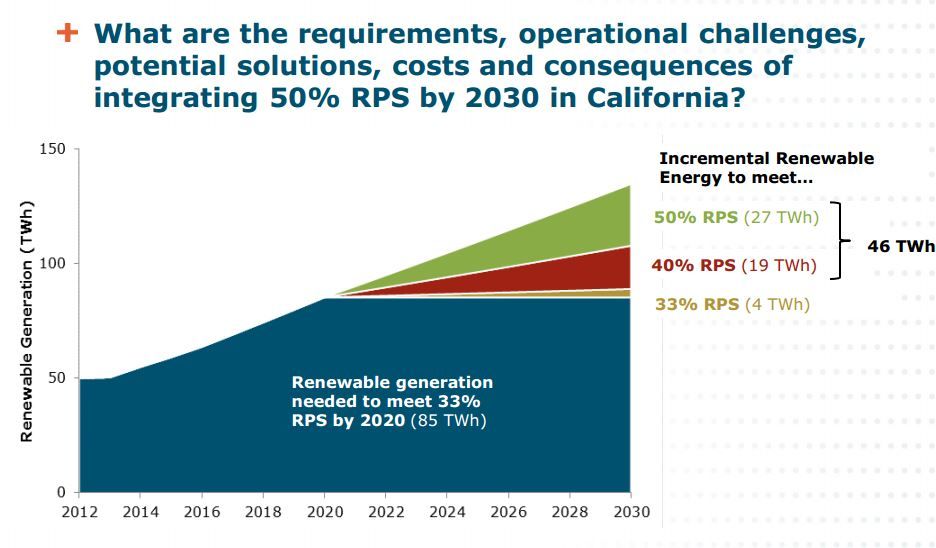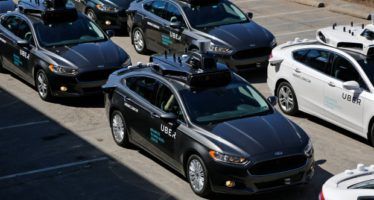Reaching 50 percent renewable goal won’t be easy
Yesterday Democratic leaders in the California Senate introduced a series of bills to move the state to a goal of 50 percent renewable energy by 2030. That would be an increase from the current goal of 33 percent by 2020.
The goal also was a key part of Gov. Jerry Brown’s Inaugural Address last month.
“We want the same goal,” Senate President Pro Tem Kevin de Leon said of the new bills and Brown’s agenda. “We’re on the same page.”

So, what’s the cost?
In Oct. 2014, the Little Hoover Commission asked Brown to account to Californians how much would be the cost of implementing the 33 percent standard by 2020, as mandated by AB32, the Global Warming Solutions Act of 2006. Thus far, Brown has not answered the question, let alone the cost of the higher 50 percent goal.
But the 50 percent target was looked at in a 2014 study, “Investigating a Higher Renewable Energy Portfolio Standard in California.” The study was conducted by Energy-Environmental Economics Inc. for the five largest California electric utilities: Southern California Edison, Pacific Gas & Electric, San Diego Gas & Electric, the Sacramento Municipal Utility District and the Los Angeles Department of Water and Power.
47 percent rate increase
The study has received little attention due to its highly technical content. Southern California Edison failed to respond to a request for information.
But to clarify the study, CalWatchdog.com contacted Arne Olson, E3’s lead investigator in the areas of energy policy and planning. He also prepared a slide presentation of the E3 study.
The question: How much will power rates rise by 2030?
Olson replied in an email:
“Our study projected a 47 percent increase in electric rates between 2012 and 2030 under current policy. That includes an increase of about 7 percent that can be attributed to the 33 percent RPS (Renewable Portfolio Standard) policy, and 40 percent due to other factors such as replacement of obsolescent natural gas power plants, San Onofre nuclear power plant replacement, load growth, etc.
“The study found that a 50 percent RPS policy would result in an additional increase of 9-23 percent, or 2-5 cents/kWh (kilowatt hour), depending on the renewable portfolio, in 2030 relative to the current policy baseline. This increase could be mitigated to 4-8 percent, or 1-2 cents/kWh, if the state also pursued renewable integration solutions such as increased regional coordination or flexible loads.”
The E3 study also states that rate increases could be lessened by improved grid coordination, power curtailments (Flex Alerts), or storage of green power in hydro power dams or battery storage.
Risks and problems
According to the E3 study, moving to a 50 percent green power standard also would entail the following potential risks and problems:
- There would be a trade-off of greater clean power and less grid reliability that must be mitigated by power curtailments that may be unacceptable to ratepayers (p. 15).
- Increasing green power from 33 to 50 percent will increase over-generation of solar power, resulting in power dumps that would waste energy and invested dollars and discourage lenders from investing in solar power. Over-generation would increase from 1.6 percentage points of the generating hours per year under a 33 percent renewable energy standard to 23 percentage points under a 50 percent standard (Table 2, p. 14).
Other considerations
There are other considerations outside the scope of the E3 study:
- According to Utility Dive, an energy publication, many of the prior direct subsidies, tax deductions and other mechanisms for financing solar power have been discontinued and may not be available, thus increasing costs significantly.
- Utility Dive also found that renewable power, especially solar power, may not survive an increase to a 50 percent standard because of market and revenue risks due to unpredictable mandatory curtailments.
- As detailed by the Carbon Brief, “gas power costs twice as much if it only runs half the time,” as experienced in Europe. This may offset the estimated relatively cheap cost of renewable energy.
- According to a study by two professors at the University of Michigan, there are cheaper ways to reduce C02 than the methods in the E3 Study, such as energy efficiency and a carbon tax. A Renewable Portfolio Standard has been found to be twice as costly as a direct carbon tax. California, of course, also has a cap-and-trade carbon tax.
- The Michigan study attributed the adoption of an RPS mainly to partisan control of state legislatures by a Democratic majority and the symbolic power of environmental arguments. Little impact was seen from citizen environmental preferences, existing renewable energy capacity, economic benefits, jobs creation, air pollution from the electric industry or the influence of fossil-fuel providers.
- The California Air Resources Board’s Climate Change Scoping Plan of 2014 indicates that C02 reduction measures won’t work in the long run and would have to double from 2030 to 2050 to have any significant impact on global warming (p. 33).
Related Articles
Cap-and-trade could benefit new overseers
Dec. 21, 2012 By Katy Grimes The California Air Resources Board just named the American Carbon Registry and the Climate Action Reserve as
Assemblyman wants to crack down on unpermitted, self-driving vehicles
It’s not enough that Uber killed its unpermitted, self-driving-vehicle pilot program in San Francisco just a week after it started;
Why Sen. Lou Correa voted against SB 810
Jan. 29, 2010 by KATY GRIMES Yesterday the state Senate passed SB 810, the single payer health care bill sponsored



